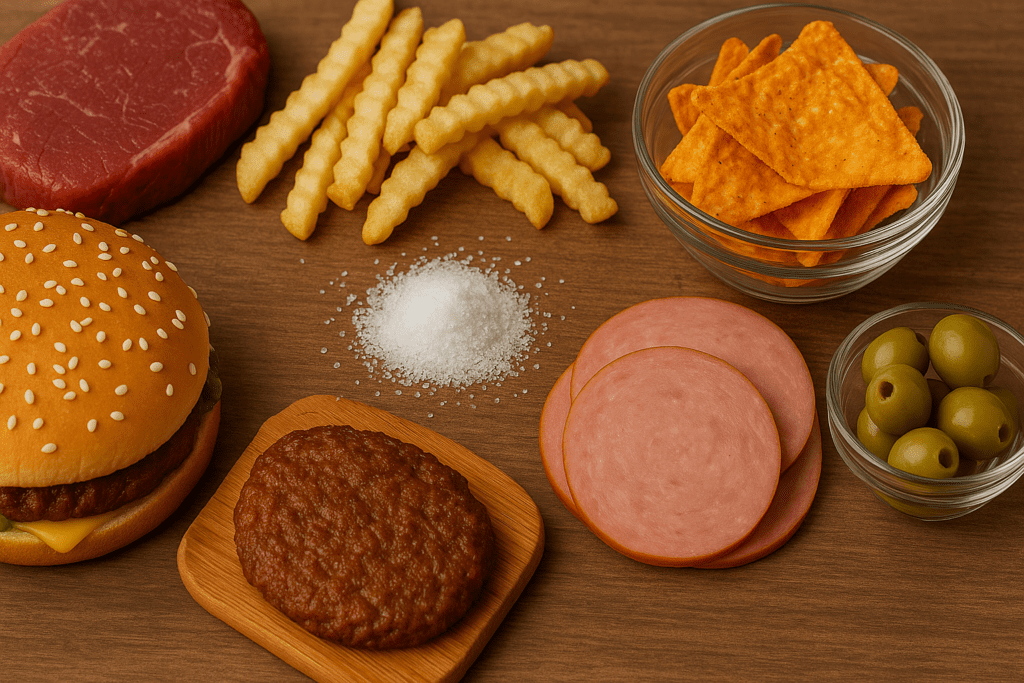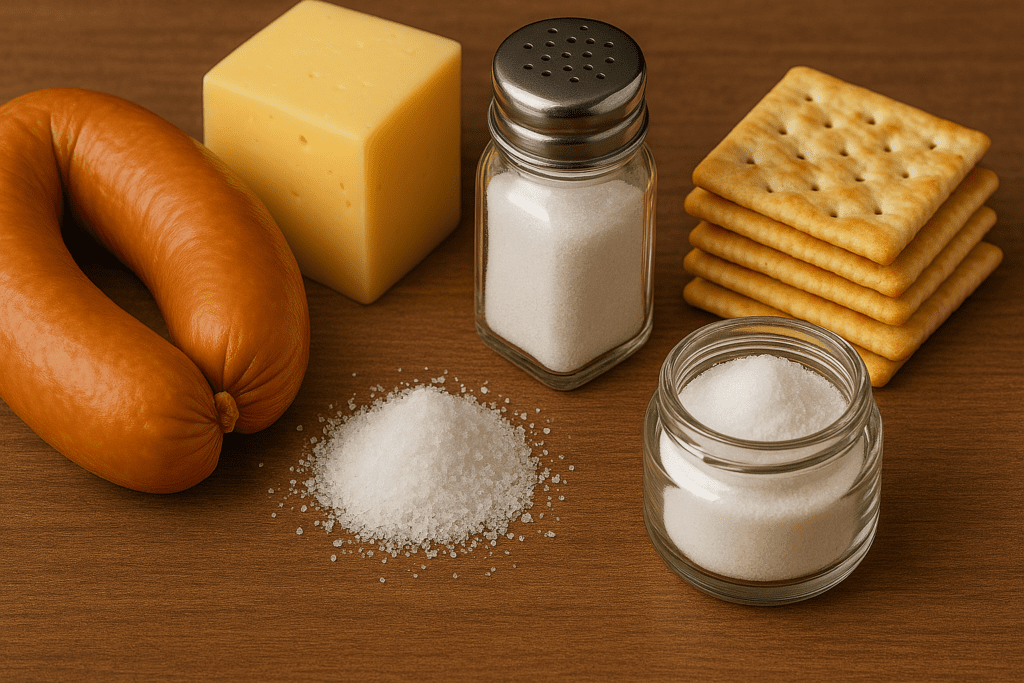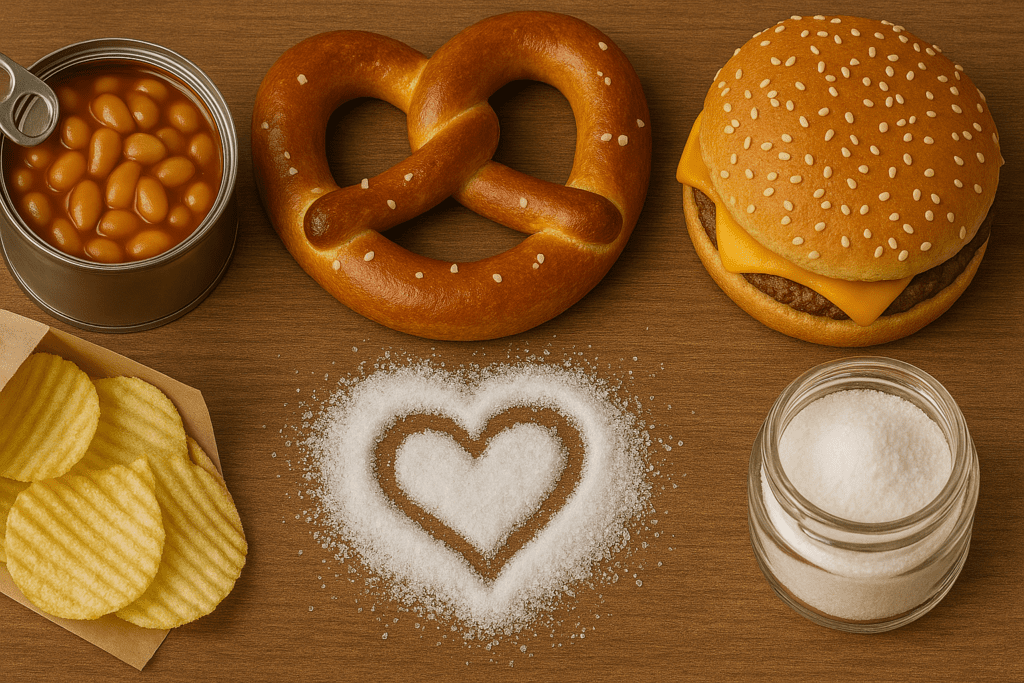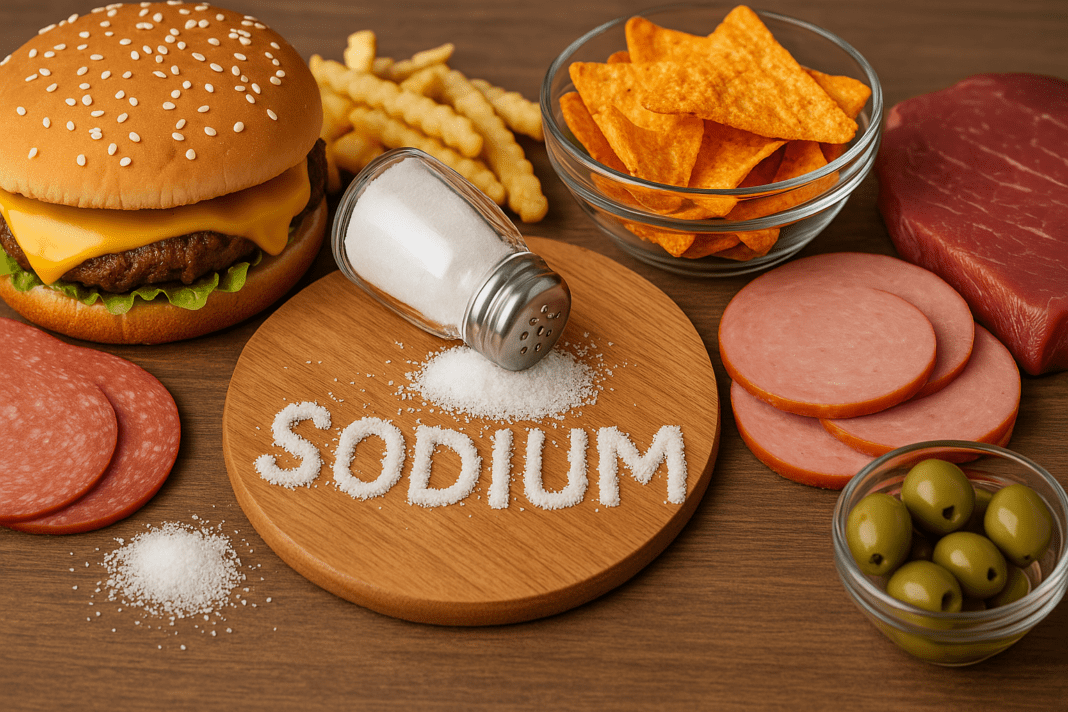Why Sodium Intake Deserves Serious Attention for Heart Health
Sodium is essential to human physiology, playing a critical role in nerve transmission, muscle function, and the maintenance of fluid balance. However, the modern diet—particularly in Western countries—has become saturated with excessive amounts of sodium, largely due to processed and packaged foods. As a result, the question of how much sodium is too much has become more than a theoretical health discussion. It’s a daily concern that affects millions of people, particularly those managing hypertension or at risk of cardiovascular disease.
You may also like: Top 15 Foods to Avoid with High Blood Pressure: What Not to Eat When Managing Hypertension
For most people, the true challenge lies not in understanding that sodium can be harmful in excess, but in quantifying what constitutes excess in real, practical terms. Phrases like “how many mg of sodium per day” or “how much salt should you eat a day” are frequently searched by those trying to navigate complex nutritional labels and dietary guidelines. Yet the answers are not always as straightforward as they appear. In this article, we will explore the scientific evidence, medical recommendations, and real-world implications surrounding daily sodium intake, aiming to provide a clear, trustworthy, and research-backed resource.
The Biological Role of Sodium and Why It Matters
Before we can understand how much sodium you should consume in a day, it’s important to understand what sodium does in the body. Sodium, primarily consumed as sodium chloride or table salt, helps maintain proper fluid balance, supports muscle contractions, and facilitates nerve impulse transmission. In small amounts, sodium is vital. Without it, the body cannot function properly.
However, the body requires only a modest amount to perform these roles. Most individuals easily surpass this threshold without realizing it. For example, how is 75mg of sodium relevant? It’s a relatively small amount—roughly the sodium content in a serving of fresh vegetables or plain oatmeal. Compare that to the average daily sodium consumed by Americans, which hovers around 3,400 mg, according to the Centers for Disease Control and Prevention (CDC). This is far above what health experts recommend, and it’s primarily driven by the consumption of processed and restaurant-prepared foods.

Current Guidelines for Sodium Intake: What the Experts Say
The U.S. Dietary Guidelines recommend that adults consume no more than 2,300 mg of sodium per day, which is roughly equivalent to one teaspoon of table salt. However, organizations such as the American Heart Association take a stricter approach, advocating for an ideal limit of 1,500 mg per day, especially for individuals with high blood pressure, diabetes, or kidney disease. Understanding these numbers helps frame the conversation around how much sodium in a day is considered safe.
The daily allowance of sodium is not merely a guideline for optimal health—it can be a matter of life or death for individuals at high cardiovascular risk. For context, a fast food meal containing a sandwich, fries, and soda can easily exceed 2,000 mg in one sitting. When people wonder how much sodium per meal they should aim for, a good rule of thumb is to stay under 500–600 mg per meal if following a 1,500 mg daily goal. This requires careful planning and awareness of hidden sodium sources.
Gender and Age Considerations: Daily Sodium Intake for Men and Women
Although the general population guidelines apply broadly, there are nuances in how sodium affects different groups. When discussing daily sodium intake for men, it’s worth noting that men generally consume more calories and larger portion sizes than women, which often translates to higher sodium intake as well. On average, men in the United States consume around 4,200 mg of sodium daily—almost double the recommended limit. This significantly increases the risk of developing high blood pressure, a major precursor to heart attack and stroke.
The daily sodium intake for women tends to be lower, averaging around 3,100 mg, but this still exceeds recommended levels. Women who are pregnant, menopausal, or managing hormonal imbalances should be especially careful, as fluctuating hormone levels can affect blood pressure and kidney function. The key message here is not just how much sodium in one day is consumed, but how it aligns with overall cardiovascular risk factors.
Recognizing the Symptoms of Too Much Sodium
Often, the effects of high sodium consumption build gradually, with subtle early warning signs that are easy to overlook. Recognizing the symptoms of too much salt in one day can help people take preventive action before chronic disease sets in. Common early symptoms include persistent thirst, water retention (edema), frequent urination, and mild headaches. These may seem benign, but they signal that the body is struggling to maintain its sodium-water balance.
When sodium levels remain high for extended periods, the signs of too much sodium become more concerning. Elevated blood pressure, fatigue, bloating, and even shortness of breath can result from sustained high intake. These are not isolated symptoms; they are part of a broader spectrum of too much sodium symptoms that may eventually culminate in cardiovascular or renal complications. Understanding what happens if you eat too much sodium isn’t about inducing fear but about empowering people with knowledge so they can take actionable steps to improve their health.

Hidden Sources of Sodium in Everyday Foods
Many people assume they are doing well if they avoid adding table salt to their meals. Unfortunately, this is a dangerous misconception. Most sodium consumed daily comes not from the saltshaker, but from packaged, processed, and restaurant foods. Items like canned soups, frozen dinners, breakfast cereals, and even so-called “healthy” snacks such as granola bars and flavored yogurt can be shockingly high in sodium.
Understanding sodium food sources nutrition requires a close reading of labels and ingredient lists. A product labeled “low-fat” may still be loaded with sodium as a preservative or flavor enhancer. Even condiments like soy sauce, ketchup, and salad dressings contribute significantly to overall intake. A single tablespoon of soy sauce contains about 900 mg of sodium—almost two-thirds of the ideal daily target. This is where the importance of monitoring sodium consumed per day becomes critical, especially when the sodium content is hidden in unexpected places.
How to Calculate and Manage Daily Sodium Intake
Learning how much sodium daily you consume starts with understanding nutritional labels. The “% Daily Value” listed on packaging is based on a 2,300 mg daily limit. If a food item contains 20% of the daily value, it has approximately 460 mg of sodium. But tracking sodium isn’t just about numbers. It also involves awareness, habit change, and education.
Knowing how much sodium should I have in a day helps consumers make smarter food choices. Opting for fresh produce, lean proteins, and whole grains, while minimizing pre-packaged meals, is one of the most effective strategies. Planning meals ahead of time and preparing them at home also offers more control over sodium content. The cumulative effect of consistently consuming meals with lower sodium levels can dramatically reduce the risk of hypertension and other related conditions.
Interpreting the Recommended Daily Allowance for Sodium
The recommended dietary allowance for sodium for a man is technically the same as for women—2,300 mg per day—but the context of male caloric intake and lifestyle habits often justifies greater scrutiny. Men are more likely to consume fast food and red meat, both of which are high in sodium. Therefore, applying the same numeric limit across the board may not reflect real-world behaviors. Personalized recommendations based on BMI, activity level, and existing medical conditions are far more effective.
Understanding the daily amount of sodium for men also involves looking at long-term patterns. Sporadic high intake is less damaging than sustained overconsumption, yet even occasional spikes can be harmful for individuals with underlying cardiovascular issues. The emphasis should be on building dietary habits that promote consistency and awareness, rather than relying on restrictive dieting alone.
The Dangers of Excessive Salt: What Science Tells Us
Much has been written about is salt bad for you, and the answer depends largely on context and quantity. In moderate amounts, salt is not inherently harmful. However, sustained overconsumption is clearly associated with elevated risks of hypertension, heart disease, stroke, and kidney damage. The scientific consensus overwhelmingly supports the idea that lowering sodium intake improves health outcomes in both hypertensive and normotensive individuals.
Moreover, the risk of developing excessive salt symptoms is not just theoretical. Studies have shown that high sodium intake leads to endothelial dysfunction, which impairs the arteries’ ability to dilate and contract properly. This can trigger a cascade of events that eventually damages the heart and kidneys. Individuals often underestimate how much sodium can you have in a day because they associate it only with salty snacks or meals, not realizing how sodium lurks in everything from deli meats to breakfast cereal.
Decoding What Is Considered Low Sodium
Many health-conscious consumers look for products labeled “low sodium,” but this term can be misleading. According to FDA guidelines, a product labeled as “low sodium” must contain 140 mg of sodium or less per serving. But portion size matters. A food that seems low in sodium per serving may become high-sodium when consumed in larger quantities.
Understanding what is considered low sodium is crucial when trying to reduce risk factors for cardiovascular disease. Opting for foods labeled “no added salt” or “sodium-free” is often more effective than relying on “low sodium” branding. And even then, it’s important to read the full nutritional label. By becoming familiar with how much salt should you have a day, consumers can make choices that align better with their long-term health goals.
Practical Tips for Staying Within Sodium Limits
To remain within the safe threshold of how much sodium should you consume in a day, start by keeping a food journal. Tracking what you eat makes it easier to identify high-sodium patterns. Cooking at home using fresh ingredients is another effective way to limit intake. Use herbs, citrus, vinegar, and spices instead of salt to enhance flavor without adding sodium.
If you must rely on packaged foods, choose options labeled “reduced sodium” or “unsalted.” Rinse canned beans and vegetables to remove some of the added sodium. And be cautious at restaurants: ask for nutrition information, request sauces and dressings on the side, and avoid menu items with terms like “smoked,” “cured,” or “pickled,” which often signal high sodium content. Remember, the question isn’t just how much sodium in a day is allowed, but how you can sustainably stay within those limits without sacrificing enjoyment.

Frequently Asked Questions About Sodium Intake and Heart Health
1. Can climate or lifestyle affect how much sodium you need each day?
Yes, environmental conditions and lifestyle habits can significantly influence how much sodium you should consume in a day. People who live in hot, humid climates or engage in intense physical activity tend to lose more sodium through sweat, which may temporarily raise their sodium needs. For athletes or outdoor workers, maintaining proper sodium balance is crucial to prevent hyponatremia—a condition caused by low sodium levels in the blood. However, this does not mean increasing processed food intake; rather, replenishing electrolytes with balanced hydration or medically recommended sports drinks can help. While most individuals exceed the daily allowance of sodium, those with high sweat loss may need to monitor intake differently, ensuring their needs are met without increasing cardiovascular risk.
2. How accurate are nutrition labels when tracking your daily sodium intake?
Nutrition labels can offer a helpful baseline, but they aren’t always as accurate as people assume, particularly when trying to assess how much sodium in one day has been consumed. Manufacturers are allowed a variance margin in their nutrient declarations, which means the actual sodium content may differ slightly from what’s listed. In processed foods, batch differences and preparation methods can also influence sodium levels. Additionally, hidden sources like preservatives or phosphate additives may not be fully accounted for. Therefore, tracking sodium consumed per day should involve not only reading labels but also understanding how food preparation and additives can affect true intake.
3. Does your body adapt to high or low sodium diets over time?
To some extent, the human body can adapt to fluctuations in sodium intake, but not without potential health consequences. Chronic high intake may desensitize certain hormonal responses like aldosterone regulation, which could blunt the body’s ability to excrete sodium efficiently. Conversely, a consistently low sodium diet can lead to upregulation of sodium-retaining mechanisms, which may initially cause fatigue or low blood pressure in some people. Over time, a lower sodium diet becomes easier to maintain as taste preferences adjust. Still, these changes do not negate the physiological strain caused by exceeding the recommended dietary allowance for sodium for a man or woman, especially for those with preexisting heart conditions.
4. Are salt substitutes a safe alternative for reducing daily sodium?
Salt substitutes can be helpful, but they’re not universally safe or effective for everyone. Most contain potassium chloride, which can benefit those needing to lower their daily sodium intake, but this poses risks for people with kidney disease or those taking potassium-sparing medications. It’s also important to note that taste and texture differ significantly from regular salt, which can affect satisfaction and long-term compliance. While they may help you consume less sodium per meal, they shouldn’t be seen as a free pass. Anyone considering salt substitutes should first understand how much salt should you have a day based on personal health factors and consult with a healthcare provider before switching.
5. What are some psychological or behavioral triggers for high sodium consumption?
Stress, fatigue, and emotional eating are all common psychological triggers that lead to cravings for salty foods. Highly processed, high-sodium items such as chips and fast food activate dopamine pathways, creating a temporary sense of pleasure or relief. People under stress may not realize how quickly their average daily sodium intake can escalate simply through snack foods. In behavioral nutrition, it’s also recognized that salt enhances flavor in comfort foods, reinforcing habits that make it harder to reduce sodium long term. Recognizing these patterns can be crucial for reducing the daily sodium intake for women and men alike, especially for those managing chronic stress.
6. How does sodium intake interact with alcohol or caffeine consumption?
Both alcohol and caffeine can amplify the effects of sodium on fluid retention and blood pressure. Alcohol in particular dehydrates the body, prompting compensatory mechanisms that retain sodium and water to stabilize blood pressure. Similarly, caffeine is a diuretic and can increase urinary sodium loss temporarily, potentially leading to rebound sodium retention if followed by high-sodium meals. When considering how much sodium in a day is too much, it’s important to factor in not just food but also beverages that influence electrolyte balance. Those who consume these substances regularly may experience more pronounced signs of too much sodium such as bloating and elevated blood pressure.
7. Are there cultural or culinary traditions that make sodium reduction more difficult?
Yes, many cultural cuisines rely heavily on sodium-rich ingredients like soy sauce, fish sauce, cured meats, and pickled vegetables. For example, traditional Japanese, Korean, or Mediterranean diets often include foods that naturally elevate sodium consumed per day despite their otherwise healthy reputations. Modifying these diets without losing cultural significance can be challenging. However, using low-sodium alternatives or dilution techniques can help maintain tradition while staying within the daily allowance of sodium. Awareness and adaptation are key, particularly when understanding how much sodium can you have in a day without compromising heritage or flavor.
8. How do sodium needs change as people age?
As individuals age, kidney function often declines, and blood vessels become less elastic, making the cardiovascular system more sensitive to sodium. This means that even small increases in sodium can have a larger impact on blood pressure and heart function in older adults. Consequently, the daily sodium intake for men and women over age 60 should ideally be lower than the general population’s limit. Seniors should pay special attention to symptoms of too much salt in one day, such as swelling in the ankles or difficulty breathing, which may signal early signs of fluid overload. Additionally, decreased thirst perception in older adults can mask sodium-induced dehydration, making how much sodium should I have in a day even more crucial for aging populations.
9. Is 75 mg of sodium a meaningful number in daily nutrition?
Many people encounter labels with extremely low numbers and wonder, how is 75mg of sodium relevant in the context of a full day’s nutrition. While it might seem negligible, 75 mg represents about 5% of the 1,500 mg target recommended for optimal cardiovascular health. When reading multiple food labels throughout the day, these small numbers quickly add up. For those aiming to maintain or even reduce daily sodium intake, understanding that even “low-sodium” items contribute meaningfully to total intake is essential. It also highlights the importance of portion control and label awareness when trying to regulate how much sodium per meal is actually consumed.
10. What are the earliest and most overlooked signs of sodium overload?
While many are aware of blood pressure as a key marker, there are subtler, early signs of too much sodium that often go unnoticed. These can include tight rings or shoes due to water retention, increased thirst without obvious dehydration, and disrupted sleep caused by nocturia (frequent nighttime urination). Headaches, irritability, and facial puffiness are additional indicators that your daily sodium level may be too high—even before a medical diagnosis like hypertension is made. These excessive salt symptoms are your body’s way of signaling imbalance, and they provide an opportunity to reassess how much salt should you eat a day before chronic damage occurs.
Final Thoughts on Sodium, Salt, and Long-Term Heart Health
So, how much sodium is too much? The answer, grounded in decades of research and clinical observation, is any amount consistently above the recommended limit of 2,300 mg per day. For optimal heart health, aiming for 1,500 mg daily is even better. But it’s not just about hitting a number—it’s about understanding the broader implications of sodium intake on cardiovascular function, kidney health, and overall well-being.
Whether you’re wondering how much salt should you eat a day, trying to identify symptoms of too much salt in one day, or simply asking yourself how much sodium should I have in a day, the key is awareness. Building a diet based on whole, minimally processed foods is the most effective way to reduce your daily sodium levels and improve heart health. By becoming a more informed consumer, you take the first and most important step toward better health outcomes—starting with something as small, yet powerful, as the grains of salt on your plate.
salt sensitivity and heart disease, sodium and blood pressure link, fluid retention and sodium, kidney function and salt intake, hypertension dietary guidelines, low sodium meal planning, hidden salt in processed foods, heart healthy diet tips, sodium alternatives for cooking, sodium and cardiovascular health, managing sodium intake naturally, salt intake and aging, reducing sodium without losing flavor, salt cravings and brain chemistry, sodium and stroke risk, daily sodium tracking tools, nutrition labels and sodium, sodium awareness campaigns, cooking without added salt, health effects of excess sodium
Further Reading:
Sodium Intake and Health: What Should We Recommend Based on the Current Evidence?
Disclaimer
The information contained in this article is provided for general informational purposes only and is not intended to serve as medical, legal, or professional advice. While MedNewsPedia strives to present accurate, up-to-date, and reliable content, no warranty or guarantee, expressed or implied, is made regarding the completeness, accuracy, or adequacy of the information provided. Readers are strongly advised to seek the guidance of a qualified healthcare provider or other relevant professionals before acting on any information contained in this article. MedNewsPedia, its authors, editors, and contributors expressly disclaim any liability for any damages, losses, or consequences arising directly or indirectly from the use, interpretation, or reliance on any information presented herein. The views and opinions expressed in this article are those of the author(s) and do not necessarily reflect the official policies or positions of MedNewsPedia.


